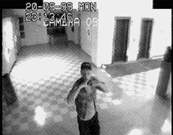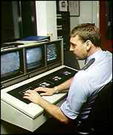 |
 |
 |
(or: 'real time' is never present - but there's nothing else present but 'real time')
In traditional video surveillance systems the respond time is an important factor. The faster the security staff realizes a dangerous situation or an illegal activity, the faster s/he can take further action and intervene.
Interaction 'in real time' is not possible with video surveillance - although the image is created. There is still and will always be a delay between the 'illegal action' and the 'legal reaction'. In some cases, the video surveillance system even just records the 'illegal action' - no interaction at all is provided.
Instead, traces are generated by recording the 'illegal actions' to some video tape - for later use by the what ever authority is in charge.



The installation 'very closed circuit TeleVision' (v.c.c.T.V.) quotes this delay and underlines it by looping the 'real time'. Every participant reades and writes traces at the same time - in 'real time'. The interaction with these traces is then again recorded and generates new traces - looped traces - for later use. Just like a video loop in a video surveillance system, old traces are deleted after the loop is once completed.
Additionally, surveillance systems are tools of power demonstration. Someone else watches / someone else cares about a specific space / someone else has the power to determine what illegal and legal actions are.
The installation v.c.c.T.V. does not differentiate between 'illegal action' and 'legal reaction' - between 'watched subject' and 'watching subject'. It simply offers the possibility to participate and interact in a very closed circuit TeleVision.
action + reaction = interaction
The interaction one is confronted with in the v.c.c.T.V. consists mostly of play with action and reaction.
((re-)action (sound))
One of the states of the v.c.c.T.V is to monitor the sound level.
By speaking into the microphone the user can distort the video image. In the background, the system records some sound samples randomly - and plays some older sound samples to the user, so that the image is created, the user could actually talk to somebody else. This is not the case. In the 'worst case', the user can hear him-/herself, the system plays some sample it just recorded.
> case 1) action: audio input :: reaction: audio output
> case 2) action: audio output :: reaction: audio input
((re-)action (video))
One of the states of the v.c.c.T.V is to monitor the motion on the video image.
By moving in front of the camera, the user can move a blured field on the screen. In the background, the system records some pictures randomly - and shows some older pictures to the user, so that the image is created, the user could actually watch somebody else 'in real time'. This is not the case. In the 'worst case', the user can see him-/herself, the system shows some pictures it just recorded.
> case 1) action: video / motion input :: reaction: video output
> case 2) action: video output :: reaction: video / motion input
action-intersection
In addition to the audio- and motion-triggered reactions of the installation, a central randomizer triggers the action-intersection between these single factors. This means that random cross-reactions between the audio- and the video-sector interrupt the interaction from time to time. Motion in front of the camera can provoce a sound recording - and pictures are taken and / or shown according to changing sound levels.
inter.action || tempo.cam.control || inter.face || cam.research
pictures: situated1 || situated2 || close up || 3 boxes || rendered || first prototype (7pix)
contact:mail@surveilled.net